We had bought a mandatory ticket to Bagan’s Archeologocal
Zone on arrival at the airport last night which meant that we didn’t have to
bother with fishing out money every 2 minutes when seeing another pagoda or
monastery – so much easier. We had hired the same taxi driver, Lin, who had driven us
from the airport yesterday to take us around as many pagodas as we wanted or
could stand (!!) from 8am til sunset
today. Lin’s fee was only $30 which seemed very reasonable plus he spoke pretty
decent English and was a cheerful guy to be around all day long – what a
perfect combination, huh!
We had toyed with the idea of renting bikes and discovering
the pagodas by ourselves but quickly discounted that option as it was another
hot day so AC sounded really good, and biking along very narrow, dusty lanes
from pagoda to pagoda while being overtaken at times by mammoth coaches quickly
lost its appeal. Many people hire horse carts to take them around some of the
2,000 pagodas (that's not a typo either!) in Bagan but the prospect of sitting in the back of an uncomfortable
cart off and on for 10 hours also held no interest.
We knew we had 2 full days in which to see pagodas that dot
the landscape around Bagan. There has been a settlement in the region since
early in the second century when a Pyu king led his followers here.
City walls were extended in 849 but it was left to King Anawrahta, the 42nd
ruler of the Bagan dynasty, to usher in the city’s age of glory.
The main center on the plain today is at Nyaung U
about 3 miles north of the walled village
of Bagan Picturesque
Bagan Village
Our first pagoda was Schwezigon. Photos
of it follow:
We walked up the ‘stairway’ i.e. a huge series of landings through
a seemingly endless throng of souvenir sellers of lacquer ware, wood carvings,
textiles, etc before we could enter the pagoda itself.
Finally, we arrived at the pagoda itself.
Schwezigon, the prototype of all Burmese stupas built after
the rule of Anawrahta, was constructed as a center of prayer and reflection in Bagan.
We saw a procession of Buddhists praying as they neared the
central part of the pagoda and then saw a monk leading his followers in prayer.
Still, all part of the amazing Schwezigon Pagoda.
Our next stop was Kyanzittha Cave
Then we saw Gubyaukgwi
Temple
Then we walked to the nearby Gubyauknge
Temple above. More photos follow:
It had to be unlocked for us as there were no other tourists
there. I should have pointed out earlier that very, very few of the temples had
any security staff or noticeable security itself. Here, it was evident that a
woman who lived just a few feet from the temple was responsible for opening up
the temple when tourists happened by. Saw some stunning frescoes in the
temple’s interior as well as on the exterior.
Next up was
What incredible views, from each level, of pagodas all around Blu Thi.
We had found one of this artist's sand paintings that had blown down to a lower level on the pagoda. He so kindly said we could keep it when we tried to return it.
It was images like this that is why we and millions of other tourists are drawn to Bagan!
Steep enough stairs, do you think!
Oops!
The corn growing around Blu Thi Pagoda was fed to animals, Lin said.
Next up was Htilominlo Temple, located about a mile
northeast of Bagan proper on the road to Nyaung U. Photos of it below:
As with the other major temples at Bagan, there was a gauntlet of souvenir vendors to pass through first. I was amazed at how
well almost all the vendors could speak enough English to negotiate prices and
encourage willing tourists to part with their money!
English may well be the
international language but it was not uncommon at all hearing vendors speaking
French, German and even Spanish to tourists. Steven and I have been
flabbergasted traveling this year with the sheer number of French tourists in
every place we’ve been. We didn't feel that was not the case either of the last two years when we took long overseas trips.
King Nantaungmya had the temple constructed in 1211 at the place where he was chosen to be king. Four Buddha figures placed on the ground and 4 more on the first floor face the cardinal points.
We could still see some of the old murals as well as a
number of friezes.
Htilominlo Temple's exterior was probably more fascinating to see than its interior which was unusual and not because of all the souvenirs to buy all around the temple either!
Once again, a huge number of sand paintings were available for sale here.
At the temple, people were recognized for having donated exterior lights and other items, something we saw nowhere else in Bagan. When you think of the extensive damage suffered by so many of the temples around Bagan during the devastating 1975 earthquake, it made perfect sense to me that sponsorship or donations would be encouraged at all the temples.
Upali Thein Pagoda was next. In its Ordination Hall,
novices become monks and elder monks tell the younger ones how to live.
Once again, some beautiful frescoes and Buddha images.
Photos from Khayminga Temple:
Steven climbed its interior staircase but I decided not to.
We strolled around the homes that were only a few yards from the temple.
Photos of Myanmar's newly elected leader, Aung Sun Suu Kyi, were visible from outside.
How lovely seeing flowers here as they were the first we'd seen all day.
Minochanthanow Temple now. Its whitish stone made it stand apart from the other mostly red brick temples we'd been seeing til then. Photos of it below:
Alexander: Saw this sign and thought of you right away of course. I hope you come here one day and discover for yourself the beauty of Bagan.
Ananda Ochong was our next pit stop on our temple journey.
After having seen lots and lots of sand paintings at every temple, we could no longer resist their lure and we bought one here!
Immediately next to Ananda Ochong was Ananda Temple but we had a
long hike passing by many stalls before we could even get a glimpse of the
pagoda.
Photos from Ananda Temple:
Lin, our driver, told us that most tourists begin their
exploration of Bagan's ancient ruins at the Ananda
Temple
Lin had indeed chosen a good time for us to visit Ananda Temple as it was almost empty of other tourists and we were able to revel in its beauty and majesty without busloads of tourists on our heels.
Some of the statues in the temple are copies, as temple
thieves destroyed the originals. It was sad to learn the desecration of temples in Bagan has been a
serious problem for a very long time.
The pressure to buy from all the vendors at each temple
luckily was not overly intense. Almost all of them asked us and the other
tourists to please look at what they had to buy and, if we expressed any
interest whatsoever in any of the objects, the vendors were sure to be right at
our side and naming a price. The prices were always negotiable and we knew that
to end up paying about 40-50% of the original price would seal the deal. We
were always encouraged to name our price or to enter the figure on the
calculators all vendors had. Of course we quickly turned a deaf ear to those
vendors pleading with us to buy from them saying business had been slow, that we
were the first (or last) customer of the day or various other sales ploys that we had heard at virtually every temple.
All that to say, when we entered Ananda Temple
Mike and Gladys, above, live in the Toronto area and love to travel around the world as much as we do. While I was sharing shopping and negotiating tips with Gladys, Mike and Steven were sharing travel stories from 40 years ago! I hope we’ll meet up again someday as Steven and I really enjoyed our too short a time with them.
Sulamani Temple, located halfway between
and Bagan, was our next stop.
Photos from Sulamani Temple aka Pahto and Pagoda:
What beautiful archways we saw at Dhammayangyi Temple. More photos of the temple are below:
I loved the temple's almost Moorish feel and its many passageways. The stench though from doves that were nesting in the pagoda’s
rafters was almost overwhelming.
It was wonderful getting out into the fresh air again and being able to admire the puppets and marionettes hanging from the nearby trees.
After having toured 11 pagodas in about 7 hours, (not that we were counting, of course!) we finally stopped
for a shared dish of fried rice and chicken in a small restaurant overlooking the Irrawaddy River
How peaceful enjoying a bite to eat while overlooking the river.
After getting enough sustenance to tour some more temples, we then walked a few steps to the Bupaya Pagoda.
According to tradition, Bupaya Pagoda was built by the third king of Bagan (162-243) but it was more likely constructed in the nineteenth century. Because of the way it stands out on the river’s banks, it is used as a navigation aid by boats.
Hey, another gold rock!
Then we toured the Indian inspired Mahabodhi Pagoda. The temple is an exact replica of a structure of the same name in India ’s
Bihar state.
Flowers around the pagoda were stunning.
Photos from Shwegugi Temple:
Breathtaking views of surrounding temples.
Lin suggested we end the day by viewing sunset from Shwesandaw
Pagoda which meant we needed to secure a coveted spot shortly after 4 as
sunset in this part of the world happens about 5:15 .
Shwesandaw, built in 1057, was 1 of only 3 religious
structures Anawrahta built in Bagan. Its stupa enshrines some of the Buddha’s
hairs sent to Anawrahta by the king of Bago, the city we had visited on the way
back from seeing Golden Rock.
The climb to a good vantage point was a might steep one as you can see here!
You can see that it was no big secret about watching the sunset from Shwesandaw Temple!
Certainly one of the more magical spots we've ever watched the sun set.
Neither of us really relished the walk down. I wonder why!
What a bucolic scene after the stunning sunset.
Lin dropped us off near our hotel in New Bagan close to 6 so
we could look for a place to eat dinner. Over a meal, Steven and I mulled over
several options that we could do the next day. We discussed seeing more temples
but only for a half day, taking a half day boat tour up the Irrawaddy River to
a neighboring town or renting bikes and wandering around the temples on our
own. So many choices and pros and cons with each choice.
We ended up deciding
to see some more temples but only for a half day via car as that was why we had
come to Bagan in the first place. Unfortunately though, our driver Lin would
not be available but he mentioned a
friend of his who also spoke good English would be glad to take us around to
other pagodas we still wanted to see. I bet you're thinking right about now, we were gluttons for punishment wanting to see more. Only time will tell!
Posted on 12/3 from Kathmandu, Nepal.





























































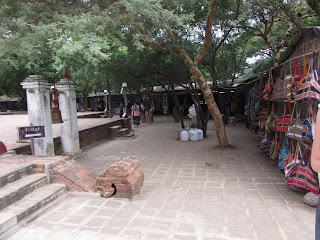




















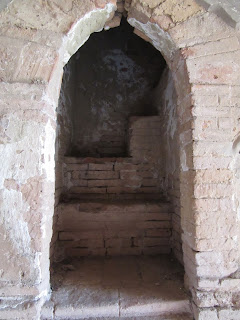








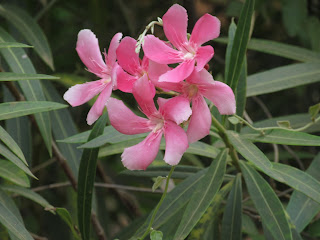








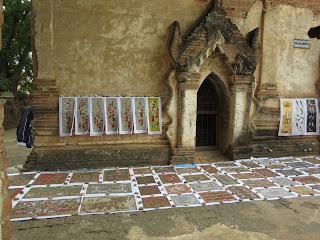
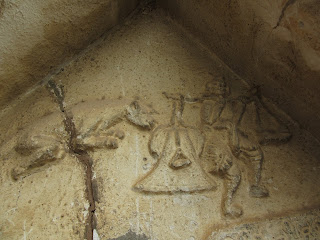

















































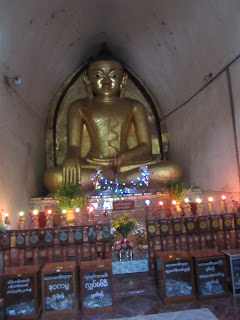



























What a beautiful sunset!
ReplyDelete